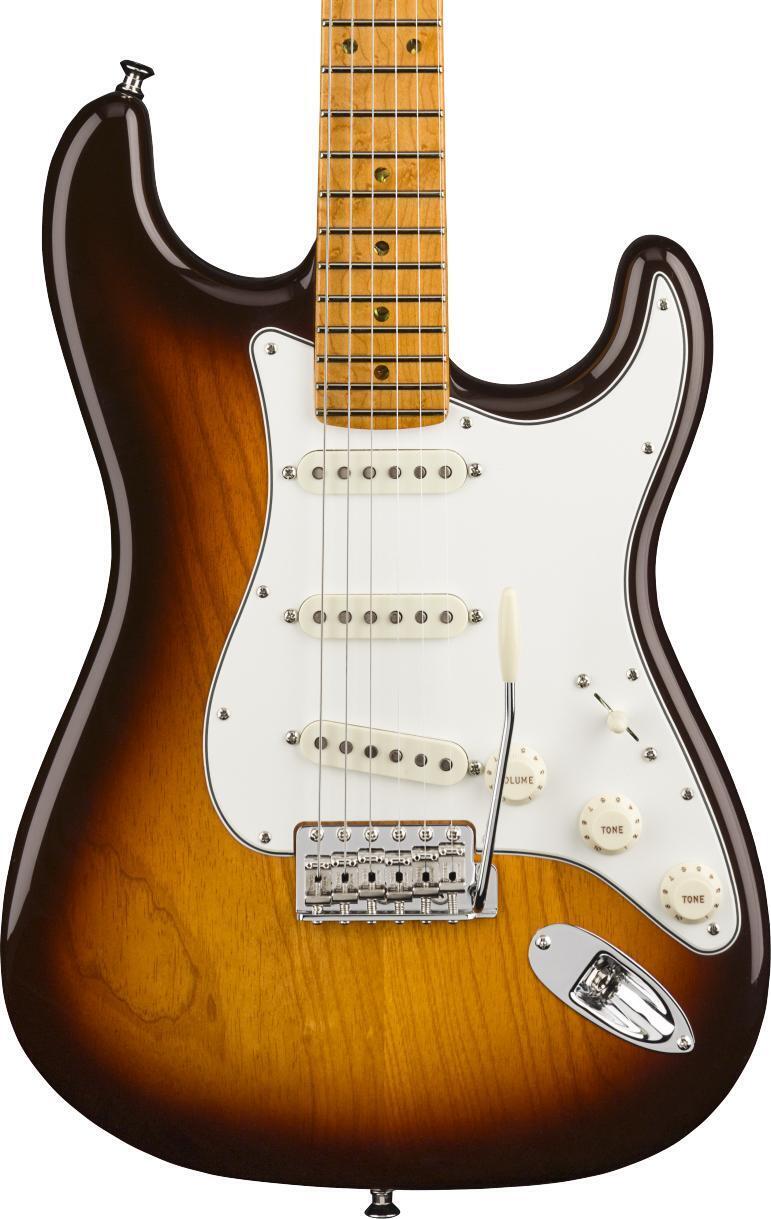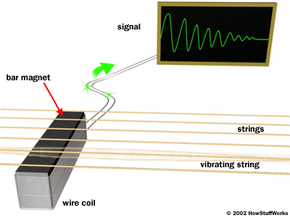Electric guitars convert string vibrations into electrical signals using pickups. These signals are then amplified to produce sound through speakers.
Electric guitars have revolutionized modern music, offering a plethora of sounds for genres ranging from rock and blues to jazz and heavy metal. Their operation hinges on the interaction between magnet-coiled pickups and metal strings. When a guitarist plucks or strums the strings, vibrations occur.
The pickups capture these vibrations and transform them into electrical impulses. These impulses travel through the guitar’s circuitry, potentially modified by onboard controls like volume knobs and tone dials or external effects pedals, before reaching an amplifier. This amplified sound then emanates from the speakers, capturing the raw emotion and skill of the player. The electric guitar’s simplicity in design but complexity in function has made it an iconic instrument that continues to spawn new musical innovations.

Credit: www.sweetwater.com
The Anatomy Of Electric Guitars
An electric guitar is more than just a musical instrument—it’s a piece of modern artistry comprising various components that collaborate to produce its iconic sound. Understanding the anatomy of an electric guitar is crucial not just for musicians, but for anyone fascinated by the mechanics of music. Each part of the guitar, from its materials to its electronics, impacts the tone and playability of the instrument. In this detailed exploration, we unravel the intricate world of electric guitars, dissecting them into their core components.
Body Types And Materials
The body of an electric guitar is the large, solid piece that serves as the foundation for most of the other parts. It is often made of wood, which heavily influences the sound. Common woods include:
- Alder: Produces a balanced tone with excellent sustain.
- Mahogany: Known for its rich, warm tones.
- Maple: Offers brightness and sustain to the guitar’s sound.
- Ash: Delivers a bright, piercing tone with a pronounced sustain.
Guitar bodies come in various shapes and designs, each contributing to the instrument’s overall aesthetic and functionality. The most recognized body types are:
- Solid body: Ideal for rock and metal genres, resistant to feedback.
- Semi-hollow body: Offers a warm resonance suitable for jazz and blues.
- Hollow body: Known for its deep, rich tones, often used in jazz.
The Neck And The Fingerboard
The guitar’s neck is the elongated piece of wood that extends from the body and holds the fingerboard, frets, headstock, and tuners. Different types of wood used for the neck include maple and mahogany, each providing distinct feel and tonal properties. The fingerboard, or fretboard, is where the guitarist presses the strings to alter the pitch. Frequently made from rosewood, ebony, or maple, the fingerboard’s material and construction affect playability and tone. Essential aspects of the neck and fingerboard include:
- Frets: Metal wires that divide the fingerboard into fixed intervals.
- Inlays: Often decorative, these markers assist in navigating the fingerboard.
- Nut: A small piece of bone or synthetic material at the junction of the fingerboard and the headstock that guides the strings.
- Scale length: The distance between the bridge and the nut affects the tension and tone of the strings.
Hardware: Pickups, Bridge, And Tuners
Electric guitar’s hardware is critical for functionality and sound. The pickups convert the vibration of the strings into electrical signals. These come in two main types:
- Single-coil pickups: Provide a bright and clear sound, typically with more treble.
- Humbucker pickups: Produce a warmer, fuller tone and cancel out noise.
The bridge anchors the strings to the body and allows for intonation and height adjustments. Bridges can be fixed or equipped with a tremolo system for pitch modulation. Below are some bridge types:
- Fixed bridge: Provides stable tuning and consistent intonation.
- Tremolo bridge: Enables vibrato effects but may impact tuning stability.
Tuners, located on the headstock, allow the player to adjust the pitch of each string. The tightness and construction of the tuners influence tuning stability. Precision-crafted tuners contribute to the guitar’s overall playability.
Creating The Sound: From Strings To Speakers
The electric guitar is an icon of modern music, revered for its ability to produce a vast array of sounds. But how does this incredible instrument turn string vibrations into the music that fills arenas and fuels rock anthems? In this section, we’ll dive into the fascinating process that transforms a guitarist’s touch into the electrifying sound that emanates from the speakers, delving into string vibrations, pickup mechanisms, circuitry, amplification, and tone-shaping effects.
The Role Of Guitar Strings And Pickups
String vibrations are the genesis of an electric guitar’s sound. Pressing the strings against the fretboard and strumming or picking them sets the strings into motion, creating musical vibrations. The density, tension, and length of the strings determine the pitch of these vibrations. These physical properties ensure each note maintains its distinct sound quality, whether it is a deep growling bass or a piercing scream.
Located beneath the strings, guitar pickups work as transducers, converting these mechanical vibrations into an electrical signal. Pickups come in various types, such as single-coils, which offer a bright and punchy sound, or humbuckers, known for their fuller and warmer tone. As strings vibrate, they disturb the magnetic field around the pickups, inducing an electrical current that mirrors the string’s vibrations.
Signal Path: The Journey Through The Guitar’s Circuitry
The electrical signal generated by the pickups travels through the guitar’s circuitry. This journey begins with the selector switch, which allows the player to choose which pickups are active, followed by volume and tone controls. The user can tweak these knobs to tailor the raw signal strength and trim certain frequency ranges, crafting the nuances of the guitar’s voice. The signal then moves through the output jack, ready for the next stage of amplification.
Amplification And Effects: Shaping The Guitar’s Tone
Before reaching the speakers, the electric signal generally passes through a guitar amplifier and possibly an array of effects pedals. Amplifiers not only increase the signal’s power but they also play a crucial role in defining the sound’s character. Through components like preamp tubes, power tubes, and tone stacks, each amplifier imparts unique qualities to the signal.
- Preamp tubes boost the raw signal and shape the initial tone.
- Power tubes further amplify the signal, giving it the strength to move the speakers.
- Tone stacks and equalization (EQ) circuits refine the sound structure, allowing balance adjustment among low, mid, and high frequencies.
Effects pedals introduce additional texture and ambiance, ranging from subtle reverb and delay to aggressive distortion and overdrive. Each pedal manipulates the signal in its unique way before it ultimately reaches the speaker cabinets. Here, electrical energy is translated back into mechanical motion as speakers vibrate in sync with the signal, projecting the rich collage of sounds into the air.
Evolution And Innovation In Electric Guitar Design
Witnessing the evolution and innovation in electric guitar design offers a fascinating journey through music and technology. From the roar of rock ‘n’ roll to the smooth croon of blues, the electric guitar has been central to shaping diverse music genres. The instrument has undergone significant transformations over the years, with each change reflecting not just a shift in musical requirements, but also advancements in technology.
Historical Milestones In Electric Guitar Development
The electric guitar’s timeline brims with ingenuity, each innovation sparking a new era in music history. Here are some key milestones:
- Rise of the Electromagnetic Pickup: In the early 1930s, the electromagnetic pickup was invented, capturing string vibrations and converting them into an electric signal.
- The Solid-Body Revolution: The 1950s saw the introduction of solid-body guitars. Icons like the Fender Stratocaster and Gibson Les Paul emerged, providing enhanced sustain and minimized feedback.
- Multi-String Experiments: The late 20th century welcomed 7-string and 8-string guitars, offering an extended range for exploration.
Modern Advancements: Midi, Modeling, And Digital Integration
Today, the sheer scope of technological integration in guitar design is astounding:
- MIDI Technology: MIDI-equipped guitars can communicate with synthesizers, allowing for an orchestral range of sounds.
- Guitar Modeling: Modern guitars can digitally model the tones of classic amps and guitars, packing decades of sound into one instrument.
- Onboard Effects and Processors: Guitars now come with built-in effects and processors, giving players instant access to a palette of sounds.
Looking Ahead: The Future Of Electric Guitars
The prospect of future guitar innovation sparks excitement:
| Aspect | Innovation |
|---|---|
| Material Science | Developments in composite materials promise lighter, more resonant guitars. |
| Smart Technology | Integration with apps and IoT devices for enhanced user interfaces and learning experiences. |
| Virtual Reality | Immersive environments for instruction and performance—taking the playing experience beyond the physical space. |
Each stride in electric guitar design blends heritage with high-tech, signaling limitless possibilities for musicians in the years to come. Keep your ears tuned, as the evolution of the electric guitar is bound to surprise and inspire.

Credit: entertainment.howstuffworks.com

Credit: www.explainthatstuff.com
How Does the Electric Guitar Technology Differ from Acoustic Guitars Made by Martin?
Electric guitar technology significantly differs from acoustic guitars, particularly in sound production and construction. While acoustic guitars like Martin rely on body resonance, electric guitars use pickups and amplifiers. For those interested in specific models, Martin’s electric guitar offerings explored reveal unique features that cater to modern musicians.
Frequently Asked Questions For How Electric Guitars Work
How Does An Electric Guitar Pick Up Sound?
An electric guitar’s pickups convert string vibrations into electrical signals using magnetic induction, which an amplifier then boosts to produce sound.
Why Do Electric Guitars Sound The Way They Do?
Electric guitars produce their distinct sound through electromagnetic pickups converting string vibrations into electric signals, which amplify through speakers. Tone adjustments via components like pickups selection, tone knobs, and effects pedals further refine their unique audio character.
On What Principle Does Electric Guitar Works?
Electric guitars work on electromagnetic induction. Vibrating steel strings disrupt a magnetic field, generating an electric signal that is amplified and sent to speakers.
How Do Electric Guitars And Amps Work?
Electric guitars produce sound by converting string vibrations into electrical signals. These signals travel to an amplifier, which boosts them and sends them to a speaker, generating audible sound. Different settings on the guitar and amp modify the tone and volume of the output.
Conclusion
Electric guitars are marvels of musical technology, blending artistry with engineering. They ignite our senses, fueling creativity and expression. By understanding their mechanics, players gain deeper control over their sound. Embrace this knowledge, and let your musical journey resonate with every strum.
Keep rocking on your string-driven odyssey.
{ “@context”: “https://schema.org”, “@type”: “FAQPage”, “mainEntity”: [ { “@type”: “Question”, “name”: “How does an electric guitar pick up sound?”, “acceptedAnswer”: { “@type”: “Answer”, “text”: “An electric guitar’s pickups convert string vibrations into electrical signals using magnetic induction, which an amplifier then boosts to produce sound.” } } , { “@type”: “Question”, “name”: “Why do electric guitars sound the way they do?”, “acceptedAnswer”: { “@type”: “Answer”, “text”: “Electric guitars produce their distinct sound through electromagnetic pickups converting string vibrations into electric signals, which amplify through speakers. Tone adjustments via components like pickups selection, tone knobs, and effects pedals further refine their unique audio character.” } } , { “@type”: “Question”, “name”: “On what principle does electric guitar works?”, “acceptedAnswer”: { “@type”: “Answer”, “text”: “Electric guitars work on electromagnetic induction. Vibrating steel strings disrupt a magnetic field, generating an electric signal that is amplified and sent to speakers.” } } , { “@type”: “Question”, “name”: “How do electric guitars and amps work?”, “acceptedAnswer”: { “@type”: “Answer”, “text”: “Electric guitars produce sound by converting string vibrations into electrical signals. These signals travel to an amplifier, which boosts them and sends them to a speaker, generating audible sound. Different settings on the guitar and amp modify the tone and volume of the output.” } } ] }
